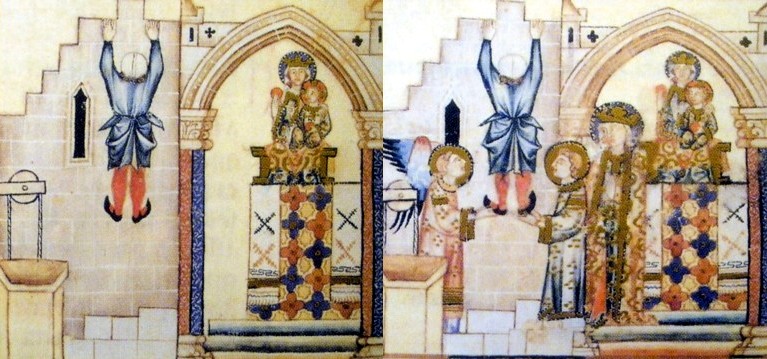Alfonso X el Sabio, 1221-1284. Cantigas de Burgos
Eduardo Paniagua · Música Antigua
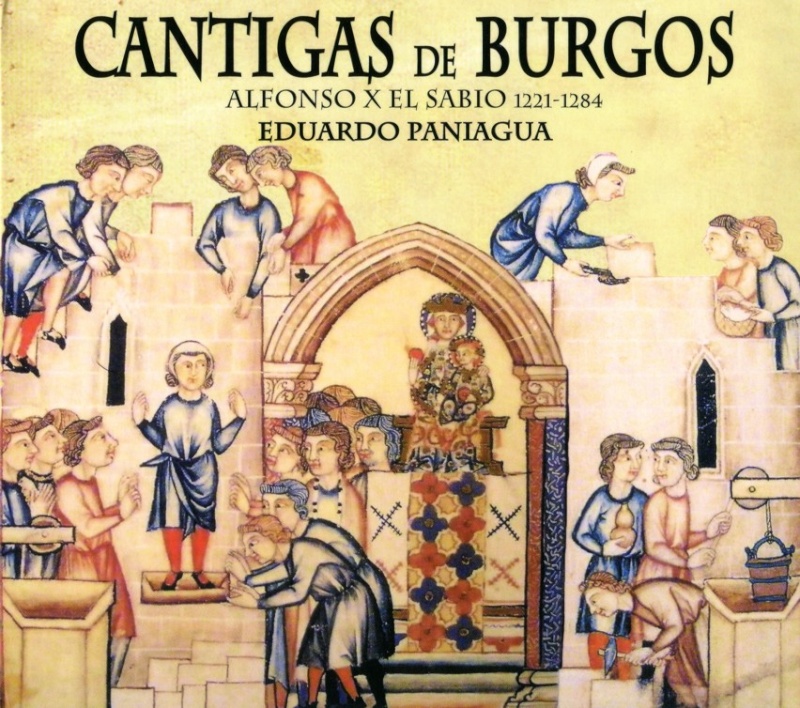
medieval.org
Pneuma «Colección Cantigas» PN-1080
2008
EL CANTERO DE CASTROGERIZ
1.
O que no coraçon d'ome [6:42]
CSM 242
LA CAÍDA DEL CANTERO DE CASTROGERIZ
2.
Aquel que de voontade [7:38]
CSM 249
LA VIGA DE MADERA DE CASTROGERIZ
3.
De muitas guisas miragres [6:09]
CSM 266
[A que Deus pres carn' e foi dela nado]
4. ENTRE LAS OLAS DEL MAR
CANTÁBRICO [3:35]
CSM 267 [= CSM 373]
SALVADOS DE LA ARENA EN CASTROGERIZ
5.
Tan gran poder a ssa Madre [8:02]
CSM 252
LA IMAGEN DEL MONASTERIO DE LAS HUELGAS
6.
Null ome per ren [6:23]
CSM 361
LA NIÑA DEL MONASTERIO DE LAS HUELGAS
7.
Por fol tenno quen na Virgen [6:13]
CSM 303
EL FRAILE DE BURGOS
8.
Poi-lo pecador punnar [12:20]
CSM 274
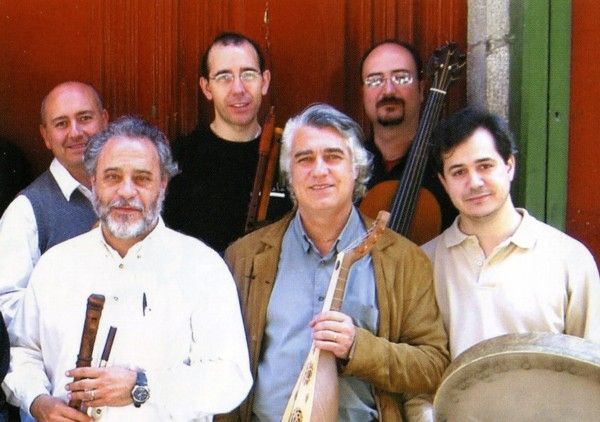
MUSICA ANTIGUA
Eduardo Paniagua
César Carazo, canto, viola
Luis Antonio Muñoz, canto, fídula
Samuel Cruz, canto contratenor
Felipe Sánchez, guitarra medieval, cítola,
vihuela de péñola
Javier Coble, órgano de mano, campanil
Jaime Muñoz, bombarda, chalumeau, axabeba,
cálamo, flabiol
David Mayoral, darbuga, dumbek, daf, pandereta,
cántara
Eduardo Paniagua, salterio, qanún, flautas dulces,
tambor, tar, gong
grabado en 2008 en Axis, Madrid, por Hugo Westerdahl
producción artística: Eduardo Paniagua
Diseño gráfico: Pneuma
Portada: Composición sobre miniaturas de la Cantiga 242
Traducción poemas: José Filgueira
Traducción de poemas: José Filgueira
English translation: Lesley Ann Shuckburgh
Producción: EDUARDO PANIAGUA • 2008 PNEUMA
Depósito Legal: M-52343-2008
Comunidad de Madrid • La Suma de Todos
Editado con la colaboración de
Caja de Burgos • Obra Social
English liner notes
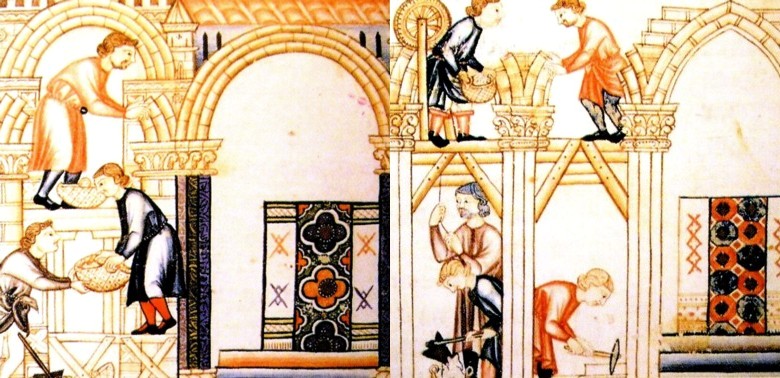
CANTIGAS DE BURGOS
Estas cantigas localizadas en Burgos nos muestran un pequeño
ciclo de milagros en torno a la construcción de la iglesia de
Santa María de Castrogeriz recogidas en los códices de
Florencia y de El Escorial. La cercanía entre sí, aunque
en diferente orden en cada códice, junto a la indicación
"compuse este cantar" puede indicarnos que el rey Alfonso X sea el
autor del ciclo. Completan esta grabación dos cantigas del
Monasterio de las Huelgas, fundación real de Alfonso VIII,
bisabuelo de Alfonso X, al que se vinculan estas cantigas
también como autor por su implicación biográfica y
por la dulzura del lenguaje. Las melodías son muy hermosas.
1. CSM 242. EL CANTERO DE CASTROGERIZ
Santa María salva a un cantero, maestro en colocar sillares,
cuando al fallarle el equilibrio quedó colgado, sujeto de las
uñas durante gran parte del día, hasta que fue bajado por
sus compañeros.
2. CSM 249. LA CAÍDA DEL CANTERO DE CASTROGERIZ
Un maestro cantero labraba las piedras en la iglesia del Manzano de
Castrogeriz. Estando en lo más alto perdió pie y
cayó de cabeza sobre las piedras, pero Santa María le
protegió quedando ileso.
3. CSM 266. LA VIGA DE MADERA DE CASTROGERIZ
Estando en construcción la iglesia de Castrogeriz, durante el
sermón de la misa, cayó de lo alto una viga sobre los
numerosos fieles que asistían, pero milagrosamente nadie
resultó herido.
5. CSM 252. SALVADOS DE LA ARENA EN CASTROGERIZ
Unos hombres cavaban arena para la construcción de la iglesia de
Santa Maria de Castrogeriz cuando se desplomó el desmonte sobre
ellos. Les dieron por muertos, pero en el intento de rescatarles vieron
que la Virgen les había librado del demonio y de la muerte.
Todos juntos dieron loores en el propio altar de la iglesia.
6. CSM 361. LA IMAGEN DEL MONASTERIO DE LAS HUELGAS
La hermosa imagen de Santa María donada al monasterio de las
Huelgas por el rey Alfonso X confortaba y curaba de sus dolores a las
monjas. Una Nochebuena las monjas acostaron la imagen en un lecho como
si fuera una mujer de parto, pero la imagen cambió de color y se
revolvía en la cama. La congregación impresionada
lloró y rezó loores a Santa María por presenciar
tal maravilla.
7. CSM 303. LA NIÑA DEL MONASTERIO DE LAS HUELGAS
La imagen de Santa María en el Monasterio de las Huelgas de
Burgos habló a una niña educada en la Orden que
tenía miedo de su tía por haber hecho travesuras.
8. CSM 274. EL FRAILE DE BURGOS
Un fraile de Burgos que tejía una garnacha (vestidura hasta
media pierna usada comúnmente en el siglo XIII) para su
oración, entró en gran duda y dejó la Orden y el
convento. Se le apareció la Virgen y le increpó para que
terminara la garnacha y regresara al convento, pero le anunció
que moriría en un año. Recuperada su vocación fue
feliz con sus compañeros hasta el día anunciado en el que
su alma abandonó el cuerpo, en oración y sin dolor.
Eduardo Paniagua
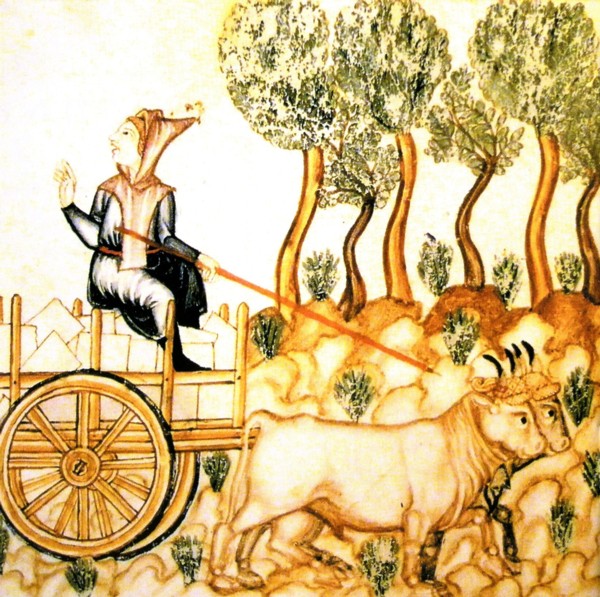
CANTIGAS OF BURGOS
These cantigas
are all set in Burgos and are about a small cycle of miracles related
to the building of the church of Santa María de Castrogeriz. They can be
found in close succession in the codices of Florence and of El
Escorial, although in a different order in each codex. This, together
with the indication "compuse este cantar" (I composed this song),
could indicate that king Alfonso X is the author of the cycle. The
recording is completed with two cantigas from the Monastery of Las
Huelgas, founded by king Alfonso VIII, great-grandfather of Alfonso X.
Alfonso VIII [sic] is also thought to be the author of these two cantigas because of the biographical references made and the sweetness of the language. The melodies are very beautiful.
1. CSM 242. THE CASTROGERIZ QUARRYMAN
Holy
Mary saves a quarryman, an expert in building with ashlars, when he
loses his balance. He is left hanging by his fingernails for most of the
day, until his colleagues help him down.
2. CSM 249. THE FALL OF THE CASTROGERIZ QUARRYMAN
A
master quarryman was carving stone in the church of Manzano de
Castrogeriz. He missed his footing when he was at the highest point and
fell head first onto the stones, but Holy Mary protected him and he was
unhurt.
3. CSM 266. THE WOODEN BEAM IN CASTROGERIZ
When the
church of Castrogeriz was under construction, a beam fell down on many
of the people in the congregation during the sermon in mass, but
miraculously nobody was hurt.
5. CSM 252. SAVE FROM THE SAND IN CASTROGERIZ
Some
men were digging up sand for the building of the church of Santa María
de Castrogeriz when the mound of sand fell in on them. They were given
up for dead but when a rescue attempt was made they were seen to have
been freed from the devil and from death by the Virgin Mary. They all
gave praise at the at altar of the church.
6. CSM 361. THE IMAGE IN THE MONASTERY OF LAS HUELGAS
The
beautiful image of Holy Mary donated to the monastery of Las Huelgas by
king Alfonso X gave comfort to the nuns and cured their ills. One
Christmas Eve the nuns put the image to bed as if it were a woman in
labour, but the image changed colour and tossed and turned in the bed.
The congregation was moved, and cried and prayed to Holy Mary giving
thanks for witnessing such a miracle.
7. CSM 303. THE GIRL AT THE MONASTERY OF LAS HUELGAS
The
image of Holy Mary in the Monastery of Las Huelgas in Burgos spoke to a
little girl who attended classes given by the Order and who was
frightened of her aunt because she had been ... [... naughty]
8. CSM 274. THE FRIAR FROM BURGOS
A
monk from Burgos was weaving a special habit for prayer (a mid-calf
garment that was commonly used in the 13th century) when his faith
suddenly wavered and he left the Order and the monastery. The Virgin
Mary appeared before him and scolded him for not finishing the habit and
told him to go back to the monastery, but She told him he would die
within a year. Having recovered his vocation he went happily back to his
companions until the appointed day in which his soul abandoned his
body, in prayer and without pain.
Eduardo Paniagua
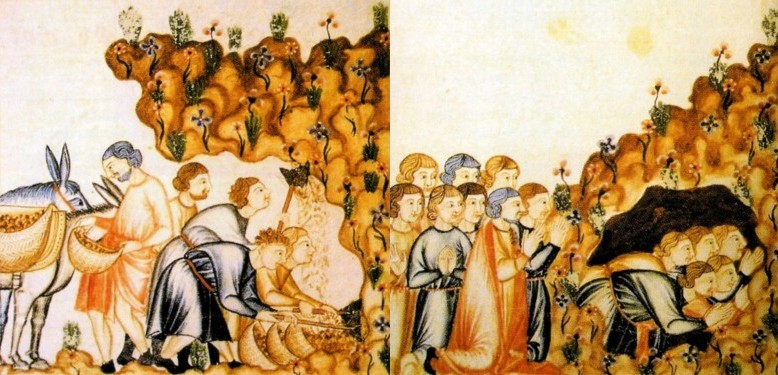
LAS CANTIGAS DE SANTA MARÍA DE ALFONSO X EL SABIO, 1221-1284.
Las
Cantigas de Santa María, comprendidas en cuatro códices de pergamino
del siglo XIII, constituye la obra lírica más importante de la España
medieval. Escritas en el idioma galaico-portugués, son cuatrocientos
veintisiete poemas que nos han llegado con su correspondiente notación
musical y adornadas con extraordinarias miniaturas. Combinan relatos de
milagros difundidos en la Edad Media con loores a la Virgen María,
testimonio de la devoción mariana que se desarrolla paralelamente a la
construcción de las catedrales góticas.
El repertorio es de
extraordinaria riqueza ya que sus melodías son todas distintas y
originales. La estructura formal de estrofas con refrán las hace aptas
para la participación popular.
Eduardo Paniagua al abordar la
grabación integral de las Cantigas, ordena estas obras según varios
criterios que dan unidad y personalidad a cada disco.
Un criterio es
la localización geográfica de las historias que se narran según las
poblaciones o los santuarios marianos que coleccionaron estos milagros.
Las Cantigas están interpretadas con todo su texto original.
Fundada en 1994 en Madrid, Pneuma comenzó con el objetivo de
publicar la música medieval española inédita hasta
el momento.
La
intención de las ediciones de Pneuma trasciende lo exclusivamente
musical, buscando el trasfondo humano y cultural de las obras
medievales. Cuando nuestros antecesores han conservado las canciones y
la música a través de tantos siglos, ya sea en los códices o en la
tradición oral, es porque las han considerado de gran valor. Ese valor
humano, cultural y espiritual, junto al valor estético musical, es el
que Pneuma quiere rescatar y mostrar, participando en el despertar a un
mundo mas culto y humanizado, que acepta la riqueza de otras tradiciones
y que aprende de lo mejor de su pasado.
THE CANTIGAS DE SANTA MARÍA OF ALFONSO X EL SABIO (THE WISE), 1221-1284
The
Cantigas de Santa María, contained in four 13th century parchment
codices, is considered to be medieval Spain's most important lyrical
work. Written in Galician-Portuguese there are four hundred and
twenty-seven poems that have been handed down to us with their
corresponding musical notation and extraordinary embellishments and
miniatures.
They combine tales of miracles popular in the Middle
Ages, with praises to the Virgin Mary and are a testament to the Marian
devotion that developed in parallel to the construction of the Gothic
cathedrals. The repertoire is extraordinarily rich as its melodies are
all different and original. The formal structure of verses with a
refrain make them apt for popular participation.
When Eduardo
Paniagua embarked on the recording of the Cantigas de Alfonso X he
organised the works according to different criteria that give unity and
personality to each recording. One criterion is the geographical
location of the stories that are told according to the villages or
Marian sanctuaries that were the scene of these miracles. The Cantigas
are performed with all their original text.
When Eduardo Paniagua
founded Pneuma in Madrid in 1994 his intention was to release
previously unrecorded Spanish medieval music.
The philosophy behind
Pneuma's recordings goes beyond the musical element in search of the
human and cultural background of the medieval works. If our ancestors
have preserved the songs and the music through so many centuries, in
codices or in oral tradition, it is because they considered them to be
of great value. That human, cultural and spiritual value, together with
the aesthetic musical value, is what Pneuma hopes to capture and bring
to light, thus participating in an awakening to a more cultured and
human world, that accepts the wealth of other traditions and learns from
the best of its past.
